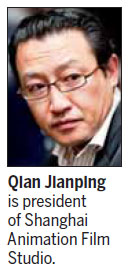When old is gold


Domestic companies turn back clock to seek out new growth, profit icons
The impending arrival of DreamWorks Animation SKG has prompted domestic animation producers like Shanghai Animation Film Studio to turn to old masterpieces for profits.
"Animation should develop based on a character that is deeply rooted in the audience's mind. When we searched through our old collections, we realized that characters like the Monkey King and Mr Black, a sheriff in the shape of a black cat, are still popular among modern audiences," says Qian Jianping, president of Shanghai Animation Film Studio.
The company produced a 3-D version of Monkey King: Uproar in Heaven as an experiment at the beginning of this year, and it was well received by the audiences, with a 90-percent-plus attendance in the first few days.
"Based on this successful attempt, we will produce a number of long-term series themed around Monkey King. Mr Black was also well-received among the audiences during an attempt made two years ago, which has prompted us to make another series based on him," Qian says.
"Therefore, the future development plan of our company is one monkey plus one cat plus X, that is, the series," says Qian with a laugh.
The inventory of Shanghai Animation Film Studio is a rich treasure trove of all genres of animation, such as water-ink cartoons, puppet cartoons and paper-cut cartoons.
"Our next plan is to revive some of these, which we are confident will prove to be popular with the audiences even now," Qian says.
Unlike The Walt Disney Company that has already created an animation kingdom in the United States, DreamWorks is making profits out of its animation productions. In China, DreamWorks is aiming to produce animation, develop peripheral products and establish a theme park, much like the Disney mode of operations.
"It would be ideal if DreamWorks can rebrand the Chinese characteristics and embroider skillfully traditional Chinese culture and beliefs into their stories," Qian says.
"We have seen a number of industries have become regulated after the entry of overseas players. If the animation giants come to China and bring in their advanced management methods and technology, I believe it will be good for the Chinese animation industry in the long run," he says.
"Following the rule of survival of the fittest, local animation companies will learn from foreign players and then try to outgrow them. Those who cannot abide by the rules will naturally be forced out. Local creative teams should be adept at handling these challenges," he says.
But Qian is also worried that companies like DreamWorks may bring in a core managing team completely composed of Americans and use China only as a processing base. "This is totally different from working together with the local creative workers and culture.
"We are trying to create a brand name of our own, much like what Disney and DreamWorks have done. Without a brand name or an industry chain, it is quite difficult for us to survive," says Qian.
The government has also encouraged the animation industry in recent years. Last year more than 15 Chinese animation movies hit the big screen, with four of them being co-productions with overseas animation companies. There were also 10 imported animation films, an unprecedented number since the reform and opening-up.
By the end of 2011, the production of animation in China reached 260,000 minutes, which is the highest in the world. However, Qian believes that even for a country like China, with a population of more than 1.3 billion people, 260,000 minutes is excessive.
"What we are lacking in is quality, and not quantity," Qian says.
shijing@chinadaily.com.cn
Today's Top News
- Xi calls for promoting volunteer spirit to serve national rejuvenation
- Xi chairs CPC meeting to review report on central discipline inspection
- Reunification will only make Taiwan better
- Outline of Xi's thought on strengthening military published
- Targeted action plan to unleash consumption momentum
- Separatist plans of Lai slammed






























